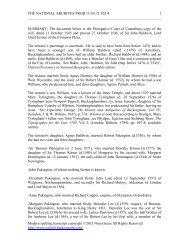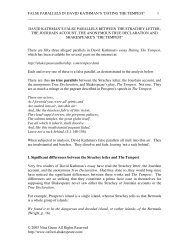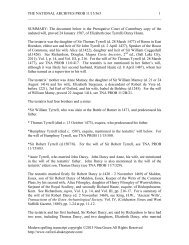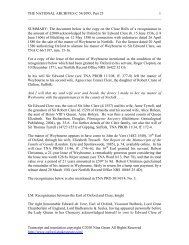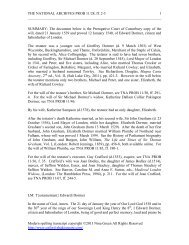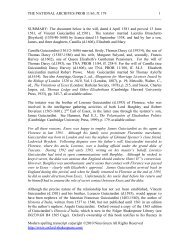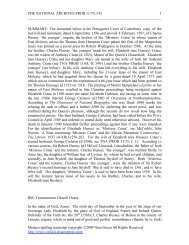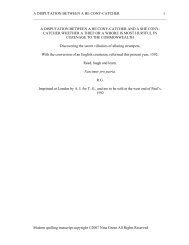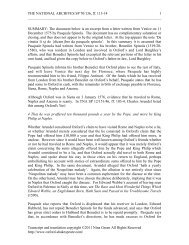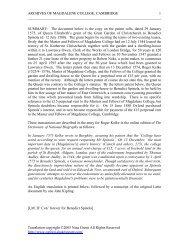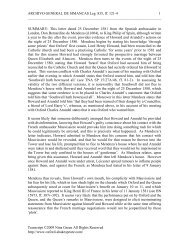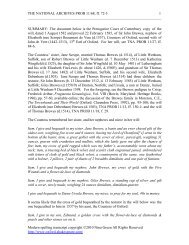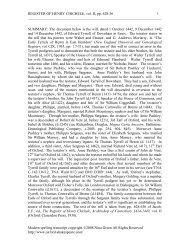Langham/ Mercer (30) - The Oxford Authorship Site
Langham/ Mercer (30) - The Oxford Authorship Site
Langham/ Mercer (30) - The Oxford Authorship Site
Create successful ePaper yourself
Turn your PDF publications into a flip-book with our unique Google optimized e-Paper software.
Was the author of the <strong>Langham</strong> Letter a <strong>Mercer</strong><br />
and a Merchant-Adventurer?<br />
In the final paragraph of the Letter, the author indeed<br />
makes these claims. He signs himself:<br />
Yoor countreeman, companion, and freend assuredly:<br />
<strong>Mercer</strong>, Merchauntaventurer, and Clark of the Councell<br />
chamber doore, and allso kepar of the same: El<br />
prencipe negro. Par me. R.L. Gent. <strong>Mercer</strong> (Kuin<br />
80).<br />
<strong>The</strong> author thus offers three significant clues to his<br />
identity: he claims to be a <strong>Mercer</strong>, a Merchant-Adventurer,<br />
and both Clerk and Keeper of the Council<br />
Chamber Door. But can these claims be relied upon?<br />
Was there a real-life Robert <strong>Langham</strong> who was a<br />
<strong>Mercer</strong>, a Merchant-Adventurer, and both Clerk and<br />
Keeper of the Council Chamber Door?<br />
<strong>The</strong> answer seems to be that no person who was all<br />
three things ever existed, and that the Keeper of the<br />
Council Chamber is one individual named Robert<br />
<strong>Langham</strong>, the <strong>Mercer</strong> is an entirely different Robert<br />
<strong>Langham</strong>, and the Merchant-Adventurer is the<br />
anonymous author himself.<br />
<strong>The</strong>re is no dispute about the fact that there was a<br />
real-life Robert <strong>Langham</strong> who held the position of<br />
Keeper of the Council Chamber. Scott has discovered<br />
several Privy Council warrants authorizing payment<br />
to Robert <strong>Langham</strong> of an annual stipend of<br />
£10 for the years 1573-1578 and 1580 for services<br />
as "Keeper of the [Privy] Council Chamber", a position<br />
which included such duties as:<br />
EDWARD DE VERE<br />
NEWSLETTER NO. <strong>30</strong><br />
Published by De Vere Press<br />
1340 Flemish Street<br />
Kelowna, B.C. V1Y 3R7 Canada<br />
provision of bowghes and flowers . . . a fier shovell,<br />
peyer of tonges, bellowse and forke for that Chamber<br />
(Scott 299).<br />
<strong>The</strong>se Privy Council warrants clarify two points.<br />
Firstly, Robert <strong>Langham</strong> was not the "Clark of the<br />
Councell chamber doore". <strong>The</strong> title held by the reallife<br />
Robert <strong>Langham</strong> was "Keeper of the Council<br />
Chamber". <strong>The</strong> author's use of the title "Clark", an<br />
entirely different position from that of "Keeper", and<br />
one requiring a superior education, appears to be<br />
both facetious and deliberately misleading. Someone<br />
who held the position of a clerk would hardly<br />
be found busying himself outside the Council Chamber<br />
door, as <strong>Langham</strong> says he does in the Letter:<br />
Noow syr, if the Councell sit, I am at hand, wait at an<br />
inch I warrant yoo. If any make babling, peas (say I)<br />
wot ye whear ye ar? If I take a lystenar, or a priar in at<br />
the chinks, or at the lokhole, I am by and by in the<br />
bonez of him: but noow they keep good order, they<br />
kno me well inough: If a be a freend, or such one az I<br />
like, I make him sit doun by me on a foorm, or a cheast,<br />
Let the rest wallk a Gods name (Kuin 77-8).<br />
<strong>The</strong>se lines cannot be interpreted as a straight-faced<br />
description by Robert <strong>Langham</strong> himself of the bustling<br />
and officious manner in which he "guards" the<br />
Privy Council Chamber door. <strong>The</strong>y seem rather to<br />
be the amused observations of an anonymous author<br />
who is enjoying a jest at Robert <strong>Langham</strong>'s expense.<br />
<strong>The</strong> Privy Council warrants also make clear the menial<br />
nature of <strong>Langham</strong>'s duties, and the fact that his<br />
salary was a mere £10 per annum. None of this is<br />
consonant with claims that the Keeper of the Coun-<br />
© August 1991, February 2001 Published Monthly
cil Chamber was also a <strong>Mercer</strong>.<br />
During the Elizabethan era, the <strong>Mercer</strong>s were foremost<br />
among the twelve great livery companies of<br />
London, trading principally in silks and other luxury<br />
fabrics (Herbert 237). A member of the <strong>Mercer</strong>s'<br />
Company was, almost by definition, a wealthy man.<br />
Is it realistic to suppose that a minor court official, a<br />
Keeper of the Council Chamber, was one of the<br />
wealthy members of this great livery company?<br />
At the beginning of the Letter, the author makes no<br />
such claim. He calls himself merely an "officer attendant<br />
in Coourt". <strong>The</strong> title page of the Letter reads:<br />
A letter whearin, part of the entertainment untoo the<br />
Queenz Maiesty, at Killingwoorth Castle, in warwik<br />
Sheer, in this soomerz Progress. 1575, iz signified:<br />
from a freend officer attendant in Coourt, untoo hiz<br />
freend a Citizen, and Merchaunt of London (Kuin 35).<br />
On the following page, the author identifies the<br />
friend who is a "Citizen, and Merchaunt of London".<br />
He is "my good freend, Master Humfrey Martin<br />
<strong>Mercer</strong>" (Kuin 36).<br />
<strong>The</strong>re is historical evidence of Humfrey Martyn's<br />
membership in the <strong>Mercer</strong>s' Company. He was admitted<br />
to the Company by patrimony in 1570 (Kuin<br />
13). But what of Robert <strong>Langham</strong>, Keeper of the<br />
Council Chamber? As Kuin remarks, the claim that<br />
<strong>Langham</strong> was a <strong>Mercer</strong> can be checked:<br />
while anyone could call himself a ‘citizen and merchant’,<br />
to call oneself, and one’s correspondent, (as<br />
the author does) a <strong>Mercer</strong> implies identification. For<br />
the <strong>Mercer</strong>s were, and are, one of the great Livery<br />
Companies of London; and such a reference can be<br />
checked (Kuin 12-3).<br />
<strong>The</strong> records of the <strong>Mercer</strong>s' Company reveal that a<br />
Robert <strong>Langham</strong> was admitted to the freedom of<br />
the Company in 1557 by apprenticeship. However,<br />
there is no evidence to prove that this person was<br />
Robert <strong>Langham</strong>, Keeper of the Council Chamber.<br />
In fact, Bradbrook is of the view that the two Robert<br />
<strong>Langham</strong>s were not one and the same (Scott <strong>30</strong>0),<br />
and that the author of the Letter, knowing that there<br />
was a Robert <strong>Langham</strong> who was a <strong>Mercer</strong>,<br />
delibertely conflated him with Robert <strong>Langham</strong>,<br />
Keeper of the Council Chamber.<br />
This brings us to a consideration of the third claim<br />
in the conclusion of the Letter, the claim that the<br />
Keeper of the Council Chamber was also a Merchant-Adventurer.<br />
This claim can also be checked<br />
against the historical records. If, as Kuin says, "to<br />
call oneself . . . a <strong>Mercer</strong> implies identification",<br />
even more so does calling oneself a Merchant-Adventurer.<br />
Queen Mary's Charter of Incorporation of the Merchant-Adventurers<br />
of England of February 26th,<br />
1555 lists the names of 101 individuals, including<br />
seven marquises, lords and earls; thirteen knights;<br />
ten London aldermen; and such rising political figures<br />
as Sir William Cecil and Nicholas Bacon (CPR<br />
1554-5, 55-59).<br />
Queen Elizabeth's Charter of Incorporation of the<br />
Governor, Assistants and Fellowship of Merchants<br />
Adventurers of England of July 18, 1564, lists only<br />
forty-nine names. However, a blanket provision at<br />
the end includes "all persons who have been admitted<br />
Freemen of the Company of Merchants Adventurers<br />
trading to Holland, Zealand or Flanders or<br />
should hereafter have been admitted by reason of<br />
patrimony or apprenticeship" (CPR 1563-6, 178-80).<br />
It is worth noticing that among the individuals named<br />
in Queen Elizabeth's charter are three persons related<br />
to Humfrey Martyn, the addressee of the Letter:<br />
his father, Sir Roger Martyn; his uncle, Lionel<br />
Duckett; and his relative by his father's second marriage,<br />
Edward Castelyn.<br />
<strong>The</strong> men named in both charters were prominent<br />
citizens and wealthy individuals, and the enterprises<br />
on which they were engaged demanded the expenditure<br />
of substantial sums of money. Queen Mary's<br />
Charter, for example, recites that the Merchant-Adventurers:<br />
have at their own adventure and costs provided, rigged<br />
and tackled certain ships, pinnaces and other vessels<br />
and have advanced them furnished with all things necessary<br />
to discover isles and lands unknown and not<br />
commonly frequented before this by the subjects of<br />
© August 1991, February 2001 Published Monthly
the crown, which shall chance them sailing northwards,<br />
north-westwards and north-eastwards or any part in<br />
that course which other Christian monarchies in league<br />
and amity with the king and queen have not heretofore<br />
by seas frequented, to attain by this adventure both<br />
the glory of God and the increase of the general wealth<br />
of the realms of the king and queen and their subjects<br />
(CPR 1554-5, 57).<br />
Was Robert <strong>Langham</strong>, Keeper of the Council Chamber,<br />
likely to have been a Merchant-Adventurer? <strong>The</strong><br />
available evidence suggests a negative answer. His<br />
station in life is incompatible with membership in<br />
this group; with his minor official position at court,<br />
he does not appear to have moved in the circle of<br />
commercial magnates who comprised the Company<br />
of Merchant-Adventurers. Moreover, he is not<br />
named in either of the Charters of Incorporation.<br />
This latter point does not completely rule him out<br />
because of the blanket provision covering past and<br />
future members contained in Queen Elizabeth's<br />
Charter of July 18, 1564, but on balance it seems<br />
highly unlikely that the Robert <strong>Langham</strong> who was<br />
Keeper of the Council Chamber was a Merchant-<br />
Adventurer.<br />
Interestingly, though, two of the four individuals to<br />
whom William Patten says he gave copies of the<br />
<strong>Langham</strong> Letter in September, 1575 -- William<br />
Cecil, Lord Burghley, and his brother-in-law<br />
Nicholas Bacon -- were Merchant-Adventurers.<br />
Both are named in Queen Mary's Charter of 1555.<br />
In addition, Lord Burghley's son-in-law, Edward de<br />
Vere, 17th Earl of <strong>Oxford</strong>, was, in a very practical<br />
sense, a merchant adventurer. Like other members<br />
of the nobility in the Elizabethan era, <strong>Oxford</strong> was a<br />
financial backer of voyages of exploration and trade,<br />
the most notable of these being Martin Frobisher's<br />
third voyage in search of the Northwest Passage and<br />
Captain Edward Fenton's 1582-3 voyage to the East<br />
Indies. <strong>Oxford</strong> invested £<strong>30</strong>00 in the former voyage<br />
and at least £500 in the latter (see issue #2 of<br />
the Edward De Vere Newsletter).<br />
Thus, on the balance of probabilities, the author of<br />
the <strong>Langham</strong> Letter who signs himself a<br />
"Merchauntaventurer" is far more likely to have been<br />
Edward de Vere, 17th Earl of <strong>Oxford</strong>, than Robert<br />
<strong>Langham</strong>, Keeper of the Council Chamber.<br />
<strong>The</strong> concluding paragraph of the <strong>Langham</strong> Letter<br />
thus allows us to see how the anonymous author used<br />
Robert <strong>Langham</strong>, Keeper of the Council Chamber,<br />
as a persona to cover his real identity. <strong>The</strong>re was a<br />
real-life Robert <strong>Langham</strong> who was Keeper of the<br />
Council Chamber, and it is this real-life Robert<br />
<strong>Langham</strong> who was intially delighted to receive a<br />
copy of the Letter, and who wanted more copies<br />
given to him. Later, perhaps because the Queen<br />
herself, and Leicester, were displeased with the<br />
jaunty tone of the Letter, and with the possibility<br />
that it might turn the "honourable entertainment" into<br />
a "jest", <strong>Langham</strong> "complained" about the book, and<br />
the first edition was entirely suppressed. All of this<br />
is consistent with the hypothesis that the real author<br />
of the Letter was Edward de Vere, 17th Earl of <strong>Oxford</strong>,<br />
who was hundreds of miles away in Italy in<br />
July 1575 when the Kenilworth entertainment took<br />
place, but who attempted to be there in spirit through<br />
the Letter.<br />
Works Cited<br />
Calendar of the patent rolls, Philip and Mary, 1554-1555. London:<br />
His Majesty's Stationery Office, 1936. (CPR 1554-5)<br />
Calendar of the patent rolls, Elizabeth, 1563-1566. London: Her<br />
Majesty's Stationery Office, 1960. (CPR 1563-6)<br />
Herbert, William. <strong>The</strong> history of the twelve great livery companies<br />
of London, principally compiled from their grants and records.<br />
2 vols. London, 1834.<br />
Kuin, R.J.P. Robert <strong>Langham</strong>: A letter. Leiden: E.J. Brill, 1983.<br />
Scott, David. “William Patten and the authorship of Robert<br />
Laneham’s Letter (1575)”. English Literary Renaissance 7<br />
(Spring 1977), 297-<strong>30</strong>6.<br />
© August 1991, February 2001 Published Monthly



